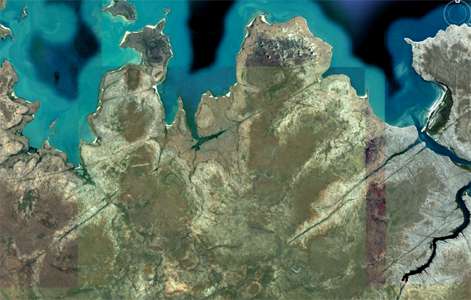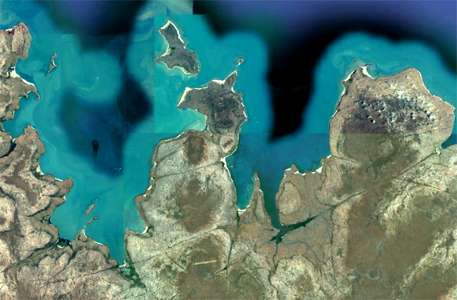Back to Don's Maps
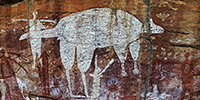 Back to Australian rock art and other Oz sites
Back to Australian rock art and other Oz sites Aboriginal Art of the Kimberleys

The King George River splits into two just before it reaches the cliffs at the head of the King George Estuary.
The true left branch has a little less water in it than the main stream during dry times, but during the wet both are very spectacular falls.
Photo: Jack, April 1996

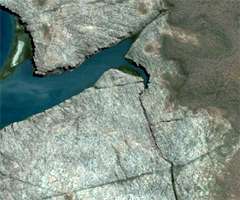
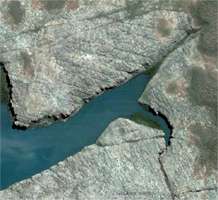
Google Earth photos of the King George estuary and a close up of the entrance of Camp Creek flowing from south to north into a side inlet in the King George Estuary via a shallow gorge.
Photo: Google Earth
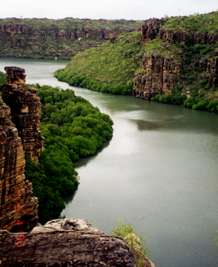

After arriving at the plateau overlooking the estuary of the King George River, the bushwalkers made camp on Camp Creek, and then walked downstream to have a look at the top of the falls.
They got a good view of the inlet that Camp Creek drops into, left. The float plane was scheduled to land on the King George River next day, then taxi in to the inlet, bringing more supplies.
On the right is the top of Camp Creek falls, where it drops over the cliffs into the side inlet of King George estuary below.
Photo: Jack, April 1996
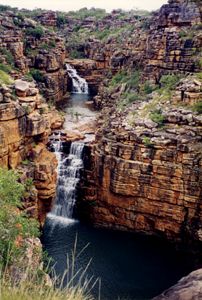

Next day, the group set out to meet the plane.
On the left is the view back up Camp Site Creek as it enters the side inlet in the King George estuary, seen on the walk down to water level.
On reaching water level, they waited a while for the float plane bringing their first food drop after leaving the Berkely River.
It rained while they were waiting, giving rise to this temporary waterfall on the other side of the inlet.
Photo: Jack, April 1996
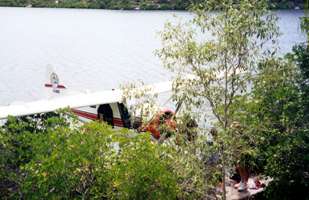
When the plane landed and taxied up to the walkers, they unloaded the supplies, and after re-organising the food and their packs, climbed back up to Camp Creek on the plateau for an overnight camp, before proceeding across the plateau to the top of the King George Falls.
Photo: Jack, April 1996
Bradshaw Paintings
Bradshaw rock paintings are a distinctive style of rock art found in the Kimberley region of Western Australia. They are named after the pastoralist Joseph Bradshaw who was the first European to discover them in 1891, whilst searching for grazing land for his cattle. The Bradshaws are also known as Gwion Gwion by the local Aboriginal people.Scientists estimate that there may be more than 100 000 sites spread over 50 000 km² of the Kimberley. In 1996 one of the paintings was dated by analysing an ancient wasp nest covering it (using thermoluminescence). The nest was found to be over 17 000 years old, indicating that some paintings are at least this old.
Debate rages as to who actually created the art. On one side of the debate is Grahame Walsh, an amateur archeologist and the leading expert on the Bradshaws with over 1.2 million images he has amassed over 21 years studying them. His hypothesis claims that the Bradshaws were painted by a culture predating present day Indigenous Australians. On the other side are the mainstream scientific community who believe that it is completely plausible that the art was produced by the local people. Controversy surrounds this debate as it is believed by some non-indigenous Australians that if the Bradshaw art is found not to be Aboriginal in origin, land rights claims by Indigenous Australians may be undermined. Regardless of whether the Bradshaw art is Aboriginal or exotic, "mainstream" Indigenous art is also found in the Kimberley region - proof that Indigenous people have inhabited and had cultural connection to the area.
Text: adapted from Wikipedia
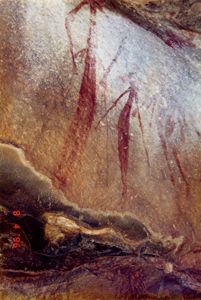
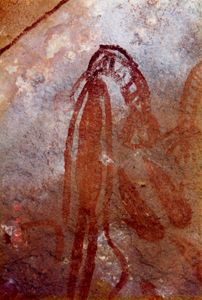

Bradshaw figures at the Camp Creek gallery.
According to legend, the Bradshaw figures were made by birds. It was said that these birds pecked the rocks until their beaks bled, and then created these fine paintings by using a tail feather and their own blood. This art is of such antiquity that no pigment remains on the rock surface, and it is impossible to use carbon dating technology. The composition of the original paints cannot be determined, and whatever pigments were used have been locked into the rock itself as shades of mulberry red, and have become impervious to the elements.
Fortuitously, in 1996 Grahame Walsh discovered a Bradshaw painting partly covered by a fossilised mud wasp nest, which scientists removed and analysed, determining it to be more than 17 000 years old.
Text adapted from: http://www.bradshawfoundation.com/bradshaws/
Photo: Jack, April 1996
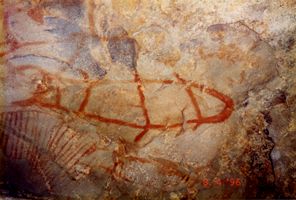
Fish, at the Camp Creek gallery.
Photo: Jack, April 1996
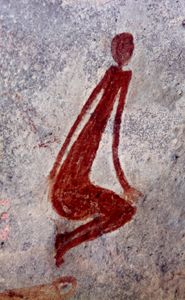
This is probably a modern painting, after white contact. It does not fit in to traditional aboriginal painting traditions. At the Camp Creek gallery.
Photo: Jack, April 1996
The next day the bushwalkers continued up Camp Creek gorge, and found more paintings before getting up onto the plateau itself.
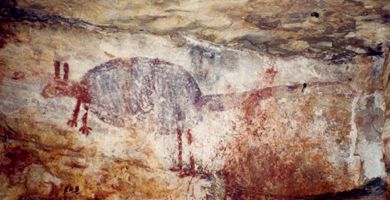
This painting of a marsupial has erect ears, front legs shorter than the back, and a long, heavy tail. The painting was found just after leaving camp at Camp Site Creek.
Photo: Jack, April 1996
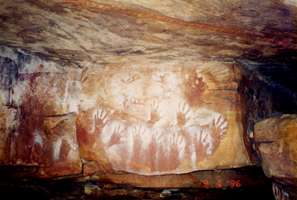
Hand stencils. These are very traditional in Australian aboriginal art, though relatively rare in European stone age art, the Grotte de Gargas in the south of France being a notable exception.
Note that all the stencils here are of the left hand, implying right handed artists.
Note also the stencil of a right foot on the lower left side of this image, with a possible left foot beside it, and a painted image reminiscent of a ladder on the roof of the gallery, though with a possible "head" on the left of the image, leading to the possibility of the image being that of a snake.
There is a similar part image of a snake/ladder on the wall of the gallery, as though it is more a symbol than a drawing of an animal such as a snake.
Photo: Jack, April 1996
The walkers then continued across the plateau, and swam across the King George River, floating their packs in front of them, then followed the river down to the falls.
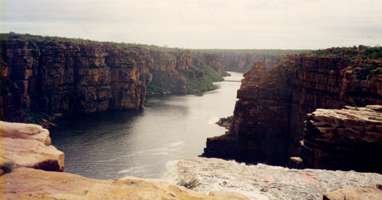
View from the top of the main falls, looking down into the King George estuary. Note that 20 000 years ago, sea level was 130 metres lower, and the view would then have been onto a thickly vegetated fresh water river valley, rather than an estuary.
Photo: Jack, April 1996
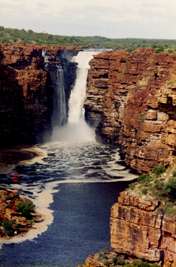
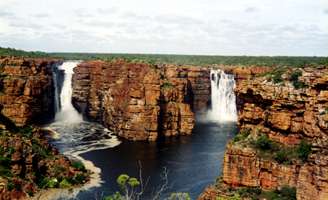
The group continued along the cliff line, to get spectacular views of the main falls.
Photo: Jack, April 1996
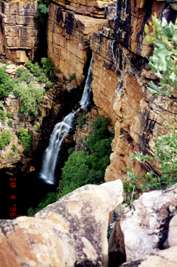
Falls on a side creek below the main falls.
Photo: Jack, April 1996
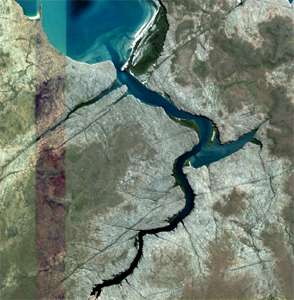
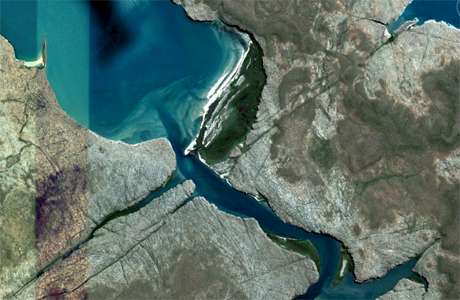
After leaving the King George falls, the group headed north-west towards a long, thin peninsula on the coast, to the west of the entrance to the King George estuary.
Photo: Google Earth

It is unusual to see such a long and narrow peninsula of fairly even width jutting so far out to sea. Note the sand bar and lagoon behind it to the west of the peninsula.
Photo: Google Earth 2004/2005
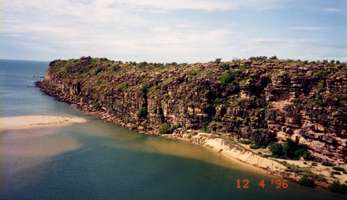
There was a creek running into the sea over a waterfall on the western side of the peninsula, which emptied into a lagoon behind the sand bar. This photo appears to have been taken at high tide, when the sand bar was much narrower than shown in the (later) Google Earth image above, or perhaps in the ten years between the photographs the sand bar has increased in width, as shown in the Google Earth image.
Photo: Jack, April 1996
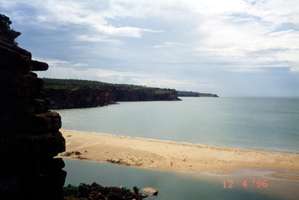
Looking to the west, we can see the rest of the sand bar and the coastline. Note the lack of surf, typical of tropical coastlines in this part of the world. Reefs and many islands mean that there is little swell to make waves in tropical areas such as this, and sand dunes are typically very low or non-existent.
Photo: Jack, April 1996
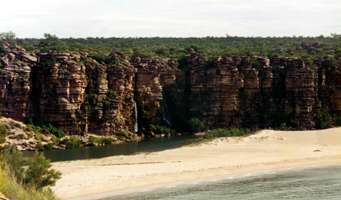
Walking out onto the peninsula itself, the waterfall where the creek on the western side of the peninsula enters the lagoon behind the sand bar may be clearly seen.
Photo: Jack, April 1996

This photo was taken from the eastern side of the peninsula, and shows the entrance to King George estuary. Note the build up of sand and resultant vegetation on the left of the entrance, presumably brought down by the King George River, a build up which is quite striking on the google earth image of the estuary mouth.
Photo: Jack, April 1996
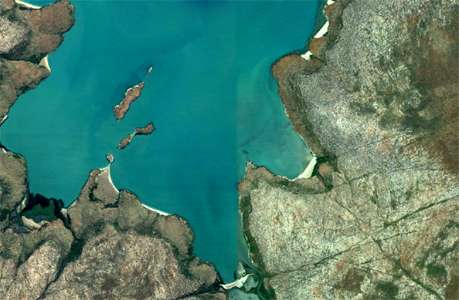
The walkers continued west from the peninsula across the plateau to this large bay containing reefs and islands, and camped at a fresh water creek emptying as a waterfall over low cliffs into a tidal inlet near the ocean.
Photo: Google Earth
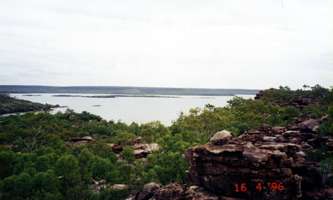
Looking out to sea from above the fresh water creek campsite.
Note the islands in the bay.
Photo: Jack, April 1996
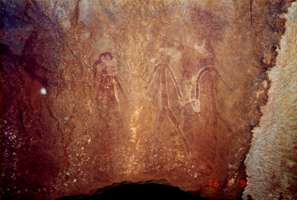
Near camp, there were a number of artworks on the valley walls.
The three male figures are outlined in white and coloured in red. One has a red head dress or hair, and the other two have white head dresses or hair.
Photo: Jack, April 1996
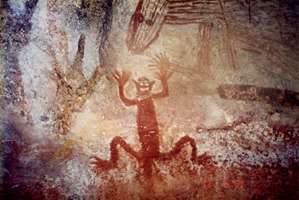
This appears to show two spirit figures. The most obvious is the four or five fingered "monkey" spirit, with a tail or penis extending below the body, and shaped something like a human. It is outlined in white, and coloured fully in red, and the mouth and eyes are in white.
Another is the figure above it and overlapped by it, showing that it is older than the first. It is more like a kangaroo, shown with a bent front right limb, which is distinguished by having a hand with at least seven fingers on it. It is outlined in red, and has been coloured by a series of lines, following the contours of the outside of the particular body part being depicted.
The paintings are actually quite small, as can be seen by the stencil of a left hand, in white, on the left of the image.
Photo: Jack, April 1996
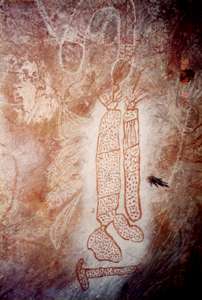
This painting shows a number of spirit figures, including at least the head of one with eyes outlined by white dots, with a headpiece, shaped rather like a snake, draped over the eyes.
As well, there are the figures with somewhat cylindrical bodies, one with bloated legs, the other with none, and both with hair which sticks straight up from the proportionately very small heads. Below these two is what may be an axe, with a head and a long handle.
Photo: Jack, April 1996
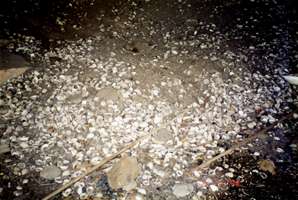
Shells in a huge midden at the art site.
Photo: Jack, April 1996
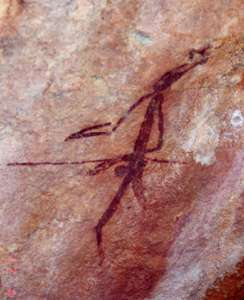
Bradshaw figure.
Photo: Jack, April 1996
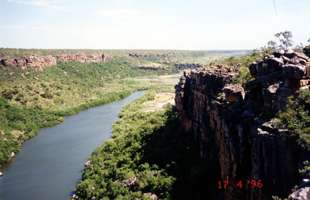
Tidal flats - looking down the creek across from the last camp.
Photo: Jack, April 1996

Waterfall into the tidal section.
Photo: Jack, April 1996
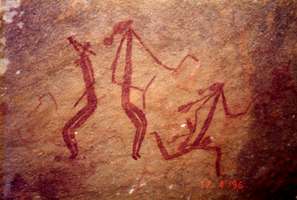
Art gallery just above the waterfall.
These dancing Bradshaw figures appear to show two men with elaborate hairstyles or head pieces, carrying boomerangs, and a woman dancer on the left.
Photo: Jack, April 1996
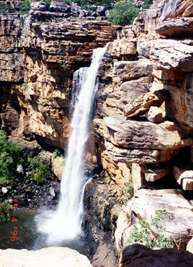
Better view of the waterfall from the other side.
Photo: Jack, April 1996

Lily pond just after leaving camp the next day.
Photo: Jack, April 1996
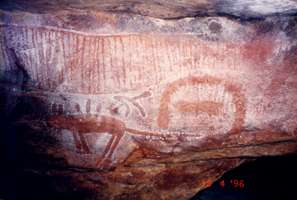
Art work near lunch stop.
Part of a large rainbow serpent appears at the top of this panel directly below an overhang. It is outlined in red, and red lines, not rows of dots, have been drawn transversely across the body. In addition there is a second outline of white above and below the rainbow serpent.
Apparently preceding this painting in time is a hand stencil partly obscured by the marsupial, as well as an enigmatic sign outlined in white dots.
The ears of the marsupial may have been completed using fingers as a stencil, but the ears, as well as the rest of the body, have then been outlined in white dots.
The "shadow" of the hand stencil shows through the marsupials body, indicating that the marsupial was coloured in using a relatively weakly coloured or sprayed layer of ochre.
To the right is the head of another spirit figure, again with a head dress draped over the head, the eyes meet in the middle, and there is apparently a median line down the forehead and between the eyes. It is apparently contemporaneous with the rainbow serpent, since the colouring is identical.
Photo: Jack, April 1996
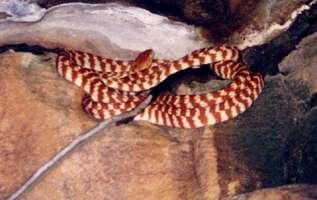
The Kimberley form of the Night Tiger, Boiga irregularis. Fully grown specimens, as shown here, have an orange-red head, and grow to 1.8 metres in length.
This specimen was using a fig tree root as support.
Photo: Jack, April 1996
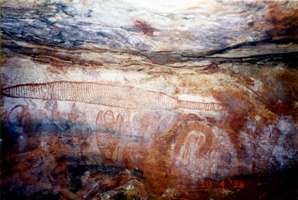
Art work near lunch stop.
This is a fascinating and important work. A fat "Rainbow Serpent" lies across the whole panel, and is outlined in red, with transverse stripes composed of dots, possibly using a finger to create the marks.
Beneath this are drawn two emu prints, and at least three spirit figures, like cartoon "ghosts" from a present day comic strip. These have eyes drawn as solid lines, with dots to colour in the rest of the figures.
In the larger figure to the left, there is a line across the neck, and the legs are indicated, as well as the arms, but not the hands.
The smaller spirit figure may have a mouth indicated.
The isolated spirit figure on the far right of the photograph also has a line across the neck, but no eyes or other features are indicated.
Below the head of the rainbow serpent is the classic figure with very large eyes and a large head-dress draped over the head.
There are indications of other figures on this panel, but there is not enough detail to make a positive identification of their nature.
Photo: Jack, April 1996
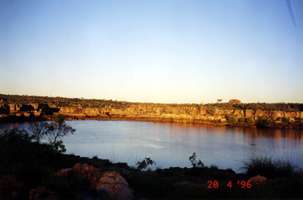
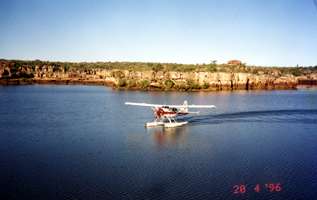
Left, early morning light on the Drysdale cliffs.
Right, float plane landing at Drysdale with the next food drop.
Photo: Jack, April 1996
The following photos are from a trip in 1998 to the central Kimberleys, at the Barnett River, near the Isdell River.
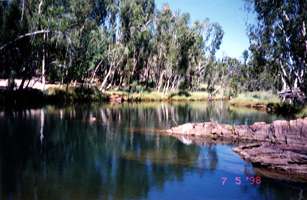
A pool on the Barnett River
Photo: Jack, May 1998
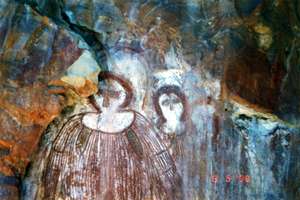
Spirit figures with what appears to be modern clothing, an all over garment with a round neckline and a pattern on the sleeves.
As well, there is a pattern repeated on either side of the central part of the dress, and colouring is by lines following the contours of the body. The heads are outlined in fine radial lines, as are the very large eyes. The nose is disproportionately large, with a swollen end. The skin is white, with no indication of a mouth on either figure. There seems to be a line on both faces joining the hair to the top of the nose.
The main figures seem to have been painted over the top of previous art works. There may be a goanna painted vertically on the lower right of this image.
Photo: Jack, May 1998
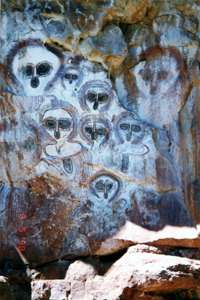
Head and shoulders spirit images in the same style as the paintings above. In this case, the dress seems to have a central pattern at the neckline. It is not an opening in the dress, since white skin is not shown beneath.
One face has a bent nose, and there is a face in the same tradition on a different panel to the right, but smudged by water trickling down the rock.
Photo: Jack, May 1998
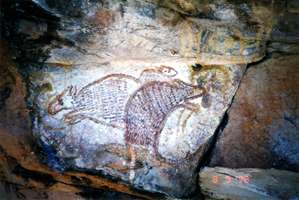
These marsupials are shown correctly as having five fingers, all much the same length.
The coat is shown in dark and ochre dots, as bands which serve to show the curvature of the body, and they are depicted as having two eyes and ears. One smaller figure appears to be on the back of the front marsupial, as though it is a baby clinging to the back of the figure. The outline is in both dark and ochre coloured pigments (the colour cast in the photo appears to have too much blue in it).
Two spirit figures like those above have been drawn in outline with ochre pigments on the right of this image, with the distinctive spirit shape of the head, eyes and nose.
A third unidentified figure in ochre appears on the left, with apparently two upside down straight stick legs and claws on the roof of the shelter.
Photo: Jack, May 1998
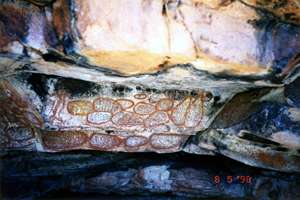
Some of these ovals may be emu eggs. However on the right there are a pair of ovals with more pointed tops which are difficult to identify.
There may be a goanna or similar animal on the left, shown head down.
Photo: Jack, May 1998
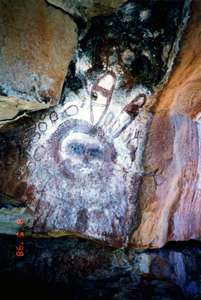
This spirit figure seems to have had its eyes touched up with a darker pigment after the original drawing. Again, there is a fringe of lines around the head and eyes, which are drawn larger than life relative to the size of the head. The face may have a mouth in this version, but it is difficult to be sure.
An interesting feature of this panel is what appears to be jelly fish with tentacles shown, surrounding the spirit face.
There is what could be an insect such as an ant or a termite shown head down on the right of the head.
Above the head, and predating it, are drawn two shapes which could be coolamons or war shields.
Above the coolamons is a figure drawn in dark red ochre which looks something like the "ghosts" of the art works near the Drysdale River, shown further up this page.
Photo: Jack, May 1998
